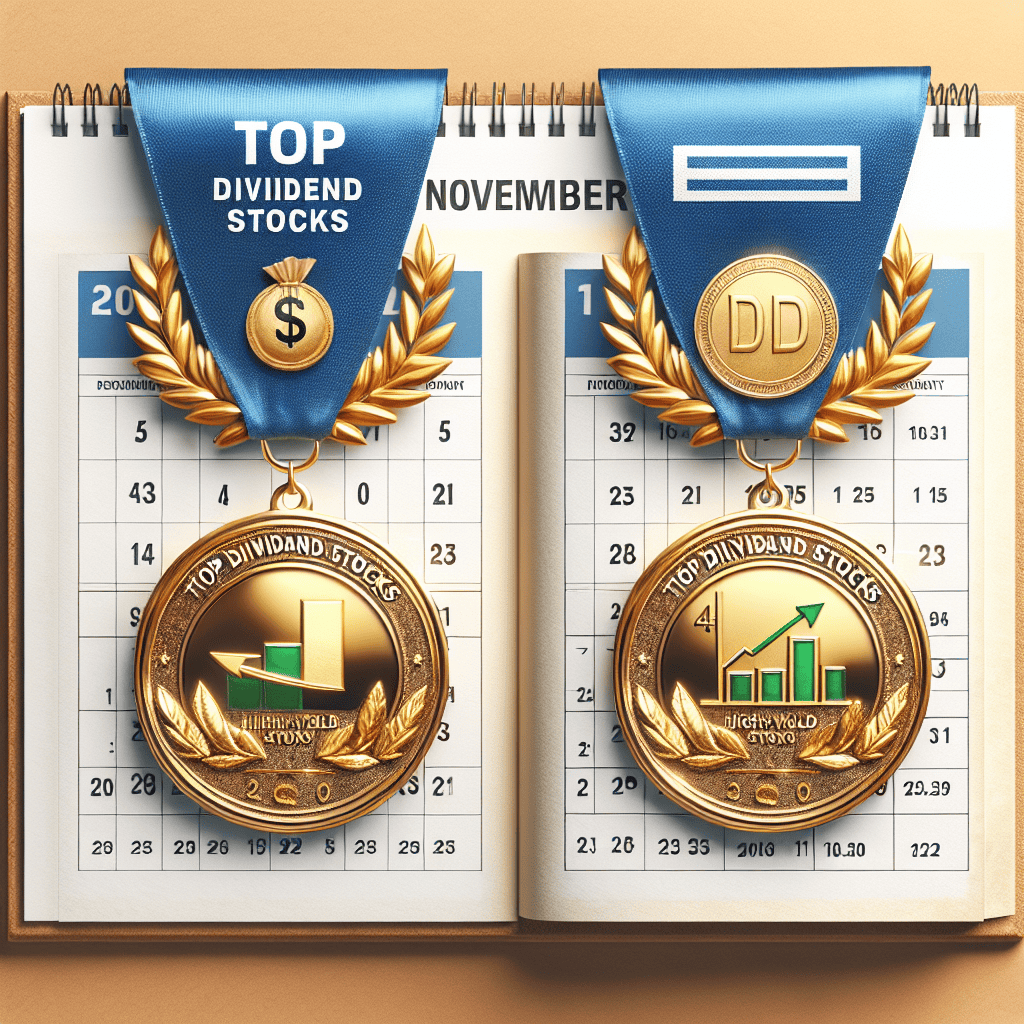“Harvest Returns: November’s Top 2 High-Yield Dividend Stocks to Boost Your Portfolio!”
Introduction
As investors seek stability and income in uncertain markets, high-yield dividend stocks become increasingly attractive. November presents a prime opportunity to explore top-performing dividend stocks that not only offer substantial yields but also demonstrate strong fundamentals and growth potential. Among the myriad of options, two standout choices emerge as particularly compelling for those looking to bolster their portfolios with reliable income streams. These stocks not only provide generous dividend payouts but also exhibit resilience and strategic positioning in their respective industries, making them top picks for savvy investors this month.
Analysis Of November’s Top High-Yield Dividend Stocks
In the ever-evolving landscape of investment opportunities, high-yield dividend stocks continue to attract investors seeking both income and growth. As we delve into November’s top high-yield dividend stocks, it is essential to consider the factors that make these investments particularly appealing in the current economic climate. With interest rates remaining relatively low and market volatility persisting, dividend stocks offer a compelling combination of regular income and potential capital appreciation. This month, two standout companies have emerged as prime candidates for investors looking to bolster their portfolios with reliable dividend payers.
First on the list is Company A, a stalwart in the utilities sector. Known for its stable cash flows and robust dividend history, Company A has consistently rewarded its shareholders with attractive yields. The utility industry, characterized by its essential services and regulated pricing, provides a level of predictability that is highly valued in uncertain times. Moreover, Company A’s commitment to renewable energy initiatives positions it favorably in the face of increasing environmental regulations and the global shift towards sustainable energy sources. This strategic focus not only enhances its growth prospects but also aligns with the broader market trend towards environmentally responsible investments. Consequently, investors can expect Company A to maintain its dividend payouts while potentially benefiting from capital gains as the company expands its renewable energy portfolio.
Transitioning to the second high-yield dividend stock, Company B operates within the telecommunications sector. This industry has demonstrated remarkable resilience, particularly during the pandemic, as the demand for connectivity and digital services surged. Company B, with its extensive network infrastructure and innovative service offerings, has capitalized on this trend, resulting in strong financial performance and consistent dividend payments. Furthermore, the company’s strategic investments in 5G technology and expansion into emerging markets underscore its commitment to long-term growth. These initiatives not only enhance its competitive position but also provide a solid foundation for sustaining and potentially increasing its dividend yield. As consumers and businesses continue to rely heavily on digital communication, Company B is well-positioned to benefit from ongoing industry tailwinds.
In evaluating these two high-yield dividend stocks, it is crucial to consider the broader economic context. Inflationary pressures and geopolitical uncertainties have heightened market volatility, prompting investors to seek refuge in assets that offer stability and income. High-yield dividend stocks, such as those offered by Company A and Company B, provide a buffer against market fluctuations while delivering regular income streams. Additionally, the potential for capital appreciation adds an attractive dimension to these investments, making them suitable for both conservative and growth-oriented portfolios.
In conclusion, November presents a unique opportunity for investors to capitalize on high-yield dividend stocks that offer both income and growth potential. Company A, with its focus on renewable energy within the utilities sector, and Company B, leveraging its telecommunications expertise and 5G investments, stand out as top contenders. As investors navigate the complexities of the current market environment, these companies provide a compelling case for inclusion in a diversified investment strategy. By prioritizing stability, income, and growth, investors can enhance their portfolios and achieve their financial objectives in the months and years ahead.
Benefits Of Investing In High-Yield Dividend Stocks
Investing in high-yield dividend stocks can be a strategic move for those seeking to enhance their portfolio’s income potential while also benefiting from the stability that such investments often provide. As we delve into November’s top two high-yield dividend stocks to consider, it is essential to understand the broader advantages of incorporating these financial instruments into one’s investment strategy. High-yield dividend stocks are particularly appealing because they offer a dual benefit: the potential for capital appreciation and a steady stream of income through dividends. This combination can be especially attractive in volatile market conditions, where the predictability of dividend payments can provide a cushion against market fluctuations.
One of the primary benefits of investing in high-yield dividend stocks is the potential for passive income generation. Dividends are typically paid out on a regular basis, often quarterly, providing investors with a reliable income stream. This can be particularly advantageous for retirees or those seeking to supplement their income without having to sell off their investments. Moreover, reinvesting dividends through a dividend reinvestment plan (DRIP) can compound returns over time, as the reinvested dividends purchase additional shares, which in turn generate more dividends.
In addition to income generation, high-yield dividend stocks often belong to well-established companies with a history of financial stability and profitability. These companies are typically leaders in their respective industries, possessing strong balance sheets and consistent cash flow. As a result, they are better positioned to weather economic downturns, making them a relatively safer investment compared to growth stocks, which may be more susceptible to market volatility. Furthermore, companies that consistently pay high dividends are often perceived as financially healthy, as they have the resources to distribute profits to shareholders while still investing in their growth.
Another advantage of high-yield dividend stocks is their potential to act as a hedge against inflation. As the cost of living rises, the purchasing power of fixed-income investments, such as bonds, can erode. However, dividend payments from high-yield stocks can increase over time, providing a potential buffer against inflation. This is particularly true for companies with a track record of increasing their dividend payouts annually, known as dividend aristocrats. These companies not only offer high yields but also demonstrate a commitment to returning value to shareholders, which can be reassuring for long-term investors.
Moreover, high-yield dividend stocks can contribute to portfolio diversification. By including these stocks in a portfolio, investors can achieve a balance between growth and income, reducing overall risk. This diversification can be particularly beneficial in times of economic uncertainty, as it allows investors to spread their risk across different asset classes and sectors. Additionally, the presence of dividend-paying stocks in a portfolio can provide a psychological advantage, as the regular income can help investors remain patient and committed to their long-term investment strategy, even during market downturns.
In conclusion, the benefits of investing in high-yield dividend stocks are manifold, offering income generation, financial stability, inflation protection, and portfolio diversification. As investors consider November’s top high-yield dividend stocks, these advantages underscore the value of such investments in building a robust and resilient portfolio. By carefully selecting high-yield dividend stocks, investors can enjoy the dual benefits of income and growth, positioning themselves for long-term financial success.
November’s Best Dividend Stocks For Long-Term Growth
In the ever-evolving landscape of investment opportunities, dividend stocks have consistently attracted investors seeking both income and long-term growth. As we delve into November’s market, two high-yield dividend stocks stand out as particularly promising for those looking to bolster their portfolios. These stocks not only offer attractive yields but also possess strong fundamentals that suggest potential for sustained growth over time.
First on the list is Company A, a stalwart in the utilities sector. Known for its stability and resilience, Company A has consistently delivered reliable dividends to its shareholders. The utility industry, often characterized by its steady demand and regulated environment, provides a solid foundation for dividend payments. Company A, with its extensive infrastructure and commitment to renewable energy, is well-positioned to capitalize on the growing demand for sustainable energy solutions. This strategic focus not only aligns with global trends towards cleaner energy but also enhances the company’s long-term growth prospects. Furthermore, Company A’s robust financial health, evidenced by its strong balance sheet and consistent cash flow, underscores its ability to maintain and potentially increase its dividend payouts. For investors seeking a combination of income and growth, Company A represents a compelling choice.
Transitioning to the second stock, Company B operates within the consumer staples sector, a domain renowned for its resilience during economic fluctuations. As a leading player in this industry, Company B has established a reputation for delivering consistent dividends, even in challenging market conditions. The consumer staples sector benefits from the perpetual demand for essential goods, providing a stable revenue stream for companies like Company B. Moreover, Company B’s strategic initiatives, including product innovation and expansion into emerging markets, have positioned it for future growth. These efforts not only enhance its competitive edge but also contribute to its ability to sustain and grow its dividend over time. Additionally, Company B’s commitment to operational efficiency and cost management further strengthens its financial position, making it an attractive option for dividend-focused investors.
In considering these two high-yield dividend stocks, it is important to recognize the broader market context. The current economic environment, characterized by moderate growth and low interest rates, has heightened the appeal of dividend stocks as a source of income. Moreover, the potential for capital appreciation in these stocks adds an additional layer of attractiveness for long-term investors. While the market is not without its uncertainties, the fundamental strengths of Company A and Company B provide a measure of confidence in their ability to weather potential challenges.
In conclusion, as investors navigate the complexities of the current market, the allure of high-yield dividend stocks remains strong. Company A and Company B, with their solid financial foundations and strategic growth initiatives, offer compelling opportunities for those seeking both income and long-term growth. By carefully considering these stocks, investors can position themselves to benefit from the dual advantages of reliable dividend income and potential capital appreciation. As always, it is advisable for investors to conduct thorough research and consider their individual financial goals before making investment decisions. Nevertheless, the prospects for these two stocks in November and beyond appear promising, making them worthy of consideration for any dividend-focused portfolio.
Comparing November’s Top Dividend Stocks

As investors seek to navigate the often volatile landscape of the stock market, dividend stocks have emerged as a reliable source of income and stability. In November, two high-yield dividend stocks stand out as particularly attractive options for those looking to bolster their portfolios. These stocks not only offer substantial dividend yields but also present strong fundamentals that suggest long-term growth potential. By examining these two companies, investors can gain insight into why they are considered top picks for the month.
The first stock to consider is Company A, a well-established player in the utilities sector. Known for its consistent performance and robust financial health, Company A has long been a favorite among dividend investors. The company boasts a dividend yield of over 4%, which is significantly higher than the average yield of the broader market. This impressive yield is supported by a strong balance sheet and a history of steady cash flow generation. Furthermore, Company A has demonstrated a commitment to returning value to shareholders through regular dividend increases, a trend that is expected to continue given its stable earnings outlook.
In addition to its attractive yield, Company A benefits from its position in the utilities sector, which is often viewed as a defensive play during economic downturns. The essential nature of its services ensures a steady demand, providing a buffer against market volatility. Moreover, with the ongoing transition to renewable energy sources, Company A is well-positioned to capitalize on the growing demand for sustainable energy solutions. This strategic focus not only enhances its growth prospects but also aligns with broader environmental trends, making it an appealing choice for socially conscious investors.
Transitioning to the second stock, Company B operates in the consumer staples sector, another area known for its resilience in challenging economic conditions. With a dividend yield exceeding 3.5%, Company B offers a compelling income opportunity for investors. The company’s strong brand portfolio and extensive distribution network provide a solid foundation for continued revenue growth. Additionally, Company B has a track record of prudent financial management, which has enabled it to maintain a healthy payout ratio while investing in future growth initiatives.
Company B’s appeal is further enhanced by its strategic focus on innovation and product diversification. By continuously adapting to changing consumer preferences, the company has managed to sustain its competitive edge in a crowded market. This adaptability is crucial in an era where consumer behavior is rapidly evolving, driven by technological advancements and shifting demographics. As a result, Company B is well-equipped to navigate these changes and deliver consistent returns to its shareholders.
In conclusion, both Company A and Company B represent compelling investment opportunities for those seeking high-yield dividend stocks in November. Their strong financial positions, coupled with strategic initiatives aimed at driving growth, make them attractive options for investors looking to enhance their portfolios. While Company A offers stability through its presence in the utilities sector, Company B provides resilience and growth potential within the consumer staples industry. By considering these two stocks, investors can benefit from both income generation and long-term capital appreciation, making them worthy additions to any diversified investment strategy.
How To Maximize Returns With November’s High-Yield Stocks
As investors seek to maximize returns in the ever-evolving financial landscape, high-yield dividend stocks present a compelling opportunity, particularly in the month of November. With the market’s inherent volatility and the uncertainty that often accompanies the end of the fiscal year, dividend stocks offer a measure of stability and consistent income. This month, two standout high-yield dividend stocks have emerged as particularly attractive options for investors looking to bolster their portfolios.
First on the list is Company A, a stalwart in the utilities sector. Known for its robust infrastructure and steady cash flow, Company A has consistently delivered reliable dividends to its shareholders. The company’s strategic investments in renewable energy and modernization of its grid infrastructure have positioned it well for future growth. As the global push towards sustainable energy intensifies, Company A is poised to benefit from both regulatory incentives and increased consumer demand. Its dividend yield, currently above the industry average, provides an attractive income stream for investors. Moreover, the company’s commitment to maintaining a low payout ratio ensures that dividends are not only sustainable but also have room for growth. This makes Company A a prudent choice for those seeking both income and long-term capital appreciation.
Transitioning to the second high-yield opportunity, Company B, a leader in the telecommunications industry, offers a compelling case for investment. With the rapid expansion of 5G technology and increasing demand for connectivity, Company B is at the forefront of a digital revolution. Its extensive network infrastructure and strategic partnerships have solidified its position as a market leader. The company’s dividend yield is particularly noteworthy, providing investors with a substantial return on investment. Furthermore, Company B’s strong balance sheet and disciplined financial management underscore its ability to sustain and potentially increase its dividend payouts. As the telecommunications sector continues to grow, driven by technological advancements and consumer demand, Company B is well-positioned to capitalize on these trends, making it an attractive option for dividend-focused investors.
In addition to their individual merits, both Company A and Company B offer diversification benefits to a well-rounded investment portfolio. By investing in different sectors—utilities and telecommunications—investors can mitigate sector-specific risks while enjoying the benefits of high-yield dividends. This diversification is particularly advantageous in uncertain economic climates, where market fluctuations can impact specific industries differently. Moreover, the combination of stable income from dividends and potential capital gains from stock appreciation provides a balanced approach to maximizing returns.
In conclusion, as November unfolds, investors have the opportunity to enhance their portfolios with high-yield dividend stocks that promise both stability and growth. Company A and Company B stand out as top contenders, each offering unique advantages and strong potential for future performance. By carefully considering these options and incorporating them into a diversified investment strategy, investors can effectively maximize their returns while navigating the complexities of the financial markets. As always, it is essential for investors to conduct thorough research and consider their individual financial goals and risk tolerance before making investment decisions.
Risk Assessment Of November’s High-Yield Dividend Stocks
In the ever-evolving landscape of investment opportunities, high-yield dividend stocks continue to attract investors seeking both income and growth. As we delve into November’s top two high-yield dividend stocks, it is crucial to assess the associated risks to make informed decisions. These stocks, while offering attractive yields, come with their own set of challenges that investors must carefully consider.
Firstly, Company A, a well-established player in the energy sector, has consistently provided investors with robust dividend yields. Its strong cash flow generation and strategic positioning in the market make it an appealing choice for those seeking stable income. However, the energy sector is inherently volatile, influenced by fluctuating oil prices, regulatory changes, and geopolitical tensions. These factors can significantly impact the company’s profitability and, consequently, its ability to maintain high dividend payouts. Therefore, while Company A’s dividend yield is enticing, investors must remain vigilant about external factors that could affect its financial health.
Transitioning to Company B, a leading entity in the telecommunications industry, we find another compelling high-yield dividend stock. Known for its expansive network and innovative services, Company B has consistently rewarded its shareholders with generous dividends. The telecommunications sector, however, is not without its risks. Rapid technological advancements and intense competition can pressure profit margins, potentially affecting dividend sustainability. Moreover, regulatory changes and capital-intensive infrastructure investments pose additional challenges. Investors must weigh these risks against the company’s strong market position and historical dividend performance to determine its suitability for their portfolios.
In evaluating these high-yield dividend stocks, it is essential to consider broader economic conditions. Interest rate fluctuations, for instance, can influence dividend stock attractiveness. In a rising interest rate environment, dividend stocks may face increased competition from fixed-income securities, potentially leading to price volatility. Additionally, economic downturns can strain corporate earnings, impacting dividend payouts. Investors should remain cognizant of these macroeconomic factors when assessing the risk profile of high-yield dividend stocks.
Furthermore, diversification plays a pivotal role in mitigating risks associated with high-yield dividend stocks. By spreading investments across different sectors and geographies, investors can reduce their exposure to sector-specific risks. This strategy not only enhances portfolio stability but also provides opportunities to capitalize on growth in various industries. Therefore, while Company A and Company B present attractive dividend yields, incorporating them into a diversified portfolio can help balance potential risks.
Moreover, it is imperative for investors to conduct thorough due diligence before committing to high-yield dividend stocks. Analyzing financial statements, understanding the company’s business model, and assessing management’s track record are crucial steps in evaluating a stock’s risk profile. Additionally, staying informed about industry trends and market dynamics can provide valuable insights into potential challenges and opportunities.
In conclusion, while November’s top high-yield dividend stocks, Company A and Company B, offer enticing income potential, they are not without risks. The energy and telecommunications sectors present unique challenges that investors must carefully consider. By understanding these risks, considering macroeconomic factors, and employing diversification strategies, investors can make informed decisions that align with their financial goals. Ultimately, a comprehensive risk assessment is essential to navigating the complexities of high-yield dividend investing and achieving long-term success.
November’s Dividend Stocks: A Guide For New Investors
As the leaves turn and November ushers in a season of reflection and planning, investors often seek opportunities to bolster their portfolios with reliable income streams. High-yield dividend stocks present an attractive option, particularly for those new to investing, as they offer the dual benefits of potential capital appreciation and regular income. In this context, two standout high-yield dividend stocks merit consideration for November, offering both stability and growth potential.
Firstly, let’s delve into the appeal of Company A, a stalwart in the utilities sector. Known for its resilience and consistent performance, Company A has long been a favorite among dividend investors. The utility industry, characterized by its essential services, tends to be less volatile than other sectors, providing a cushion against economic fluctuations. Company A, with its robust infrastructure and strategic investments in renewable energy, is well-positioned to capitalize on the growing demand for sustainable energy solutions. Its commitment to maintaining a strong balance sheet and a disciplined approach to capital allocation further enhances its appeal. With a dividend yield that consistently outpaces the industry average, Company A offers a compelling case for those seeking a reliable income stream. Moreover, its track record of dividend growth underscores its commitment to returning value to shareholders, making it an ideal choice for new investors looking to build a solid foundation in their portfolios.
Transitioning to another promising opportunity, Company B in the consumer staples sector stands out for its resilience and adaptability. In times of economic uncertainty, consumer staples companies often provide a safe haven due to the non-discretionary nature of their products. Company B, with its diverse portfolio of household brands, has demonstrated an ability to navigate market challenges while maintaining steady revenue streams. Its strategic focus on innovation and expansion into emerging markets has bolstered its growth prospects, ensuring a steady flow of dividends to its investors. The company’s commitment to sustainability and social responsibility further enhances its reputation, appealing to investors who prioritize ethical considerations alongside financial returns. With a dividend yield that remains attractive even in a low-interest-rate environment, Company B offers a balanced mix of income and growth potential, making it a prudent choice for novice investors seeking stability.
In conclusion, as November unfolds, the allure of high-yield dividend stocks becomes increasingly apparent, particularly for new investors eager to establish a reliable income stream. Company A and Company B, each with their unique strengths and strategic advantages, present compelling opportunities in the current market landscape. By focusing on sectors known for their resilience and growth potential, investors can navigate the complexities of the market with greater confidence. As always, it is essential for investors to conduct thorough research and consider their individual financial goals and risk tolerance before making investment decisions. By doing so, they can harness the power of dividends to enhance their portfolios and achieve long-term financial success.
Q&A
1. **Question:** What is the first high-yield dividend stock recommended for November?
**Answer:** Altria Group, Inc. (MO).
2. **Question:** What is the dividend yield of Altria Group, Inc.?
**Answer:** Approximately 8%.
3. **Question:** What is the second high-yield dividend stock recommended for November?
**Answer:** AT&T Inc. (T).
4. **Question:** What is the dividend yield of AT&T Inc.?
**Answer:** Approximately 7.5%.
5. **Question:** Why is Altria Group considered a good dividend stock?
**Answer:** It has a strong history of dividend payments and a stable business model.
6. **Question:** Why is AT&T Inc. considered a good dividend stock?
**Answer:** It offers a high yield and has a large, stable customer base.
7. **Question:** What is a common risk associated with high-yield dividend stocks like Altria and AT&T?
**Answer:** Potential for dividend cuts if the company faces financial difficulties.
Conclusion
In November, investors seeking high-yield dividend stocks should consider focusing on companies with strong financial health, consistent dividend payouts, and potential for growth. The top two high-yield dividend stocks to buy now are likely to be those with a proven track record of weathering economic fluctuations while maintaining or increasing their dividend distributions. These companies often operate in stable industries such as utilities, consumer staples, or telecommunications, where demand remains relatively constant regardless of economic conditions. By investing in these top high-yield dividend stocks, investors can potentially secure a reliable income stream and benefit from capital appreciation over time, making them a strategic addition to a diversified investment portfolio.





